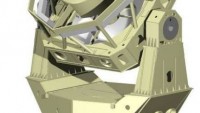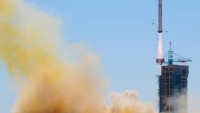US Preparing to Launch another Satellite that Spies on Chinese and Russian Satellites
| Arthur Dominic Villasanta | | Feb 16, 2017 03:51 AM EST |
(Photo : Orbital ATK) The Minotaur IV rocket that will launch SensorSat.
An upgraded, four-stage Minotaur IV launch vehicle on July 15 will launch a classified U.S. satellite built to spy on other satellites such as those from Russia and China from a unique geosynchronous equatorial orbit above the Equator.
Known as Operationally Responsive Space-5 (ORS-5), this mission run by the U.S. Air Force will orbit a small spacecraft called "SensorSat" that will track enemy satellites and other objects in geosynchronous orbit. SensorSat will also track orbital debris and test technologies for future space missions.
Like Us on Facebook
What's peculiar about the ORS-5 mission is SensorSat's 600 kilometer-high; 0 degree-inclination orbit above the Equator. The geosynchronous orbital belt, which is where most large spy satellites are located, is some 36,000 km high.
The Massachusetts Institute of Technology's Lincoln Laboratory designed and built SensorSat, which weighs between 80 kg and 110 kg. The satellite will bridge a gap in Air Force surveillance of the critical geosynchronous orbit currently provided by the Space Based Space Surveillance (SBSS) satellite launched in 2010 and due for retirement this year.
In July 2016, the air force confirmed the first of four new satellites of its SBSS system, which will better defend the U.S. military's most important in-orbit satellites, will launch in 2021.
The SBSS/Block 20 constellation will include four satellites. It will replace the current SBSS satellite, the Block 10 Pathfinder (a single satellite) equipped with a Space-Based Visible (SBV) sensor. Pathfinder was launched in 2010 into a sun-synchronous, low Earth orbit.
Pathfinder's role is to improve the ability of the air force to detect deep space objects by 80% over the Advanced Concept Technology Demonstration of the Mid-Course Space Experiment/Space-Based Visible (MSX/SBV) sensor system.
On the other hand, the Block 20 constellation will provide timely and much improved space situation awareness to meet future space control operations. It will detect and track space objects such as satellites and orbital debris, generating data the Department of Defense will use in support of military operations.
TagsMinotaur IV launch vehicle, geosynchronous equatorial orbit, Operationally Responsive Space-5, ORS-5, U.S. Air Force, SensorSat, Massachusetts Institute of Technology, Space Based Space Surveillance, SBSS/Block 20 c
©2015 Chinatopix All rights reserved. Do not reproduce without permission
 US Air Force Takes Control of Powerful DARPA Space Telescope for Tracking Spy Satellites
US Air Force Takes Control of Powerful DARPA Space Telescope for Tracking Spy Satellites Russia to Make Public a List of all US Satellites, Including Spy Satellites
Russia to Make Public a List of all US Satellites, Including Spy Satellites China Launches Second Shijian-16 SIGINT/ELINT Spy Satellite
China Launches Second Shijian-16 SIGINT/ELINT Spy Satellite Delta IV Heavy, the World’s Largest Rocket, Launches the World’s Largest Satellite -- a Spy Satellite
Delta IV Heavy, the World’s Largest Rocket, Launches the World’s Largest Satellite -- a Spy Satellite China Launches ‘Remote Sensing Satellite’; US Says it’s a Spy Satellite
China Launches ‘Remote Sensing Satellite’; US Says it’s a Spy Satellite
EDITOR'S PICKS
-

Did the Trump administration just announce plans for a trade war with ‘hostile’ China and Russia?
-

US Senate passes Taiwan travel bill slammed by China
-

As Yan Sihong’s family grieves, here are other Chinese students who went missing abroad. Some have never been found
-

Beijing blasts Western critics who ‘smear China’ with the term sharp power
-

China Envoy Seeks to Defuse Tensions With U.S. as a Trade War Brews
-

Singapore's Deputy PM Provides Bitcoin Vote of Confidence Amid China's Blanket Bans
-

China warns investors over risks in overseas virtual currency trading
-

Chinese government most trustworthy: survey
-

Kashima Antlers On Course For Back-To-Back Titles
MOST POPULAR
LATEST NEWS
Zhou Yongkang: China's Former Security Chief Sentenced to Life in Prison

China's former Chief of the Ministry of Public Security, Zhou Yongkang, has been given a life sentence after he was found guilty of abusing his office, bribery and deliberately ... Full Article
TRENDING STORY

China Pork Prices Expected to Stabilize As The Supplies Recover

Elephone P9000 Smartphone is now on Sale on Amazon India

There's a Big Chance Cliffhangers Won't Still Be Resolved When Grey's Anatomy Season 13 Returns

Supreme Court Ruled on Samsung vs Apple Dispute for Patent Infringement

Microsoft Surface Pro 5 Rumors and Release Date: What is the Latest?










